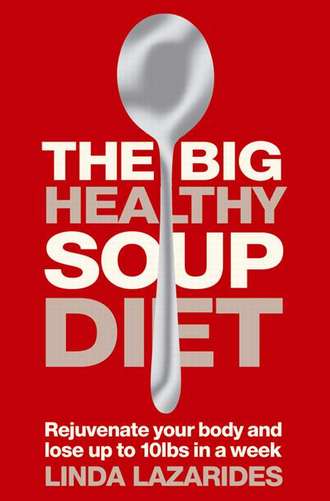
Полная версия
The Big Healthy Soup Diet: Nourish Your Body and Lose up to 10lbs in a Week
OTHER POWER FOODS TO AID WEIGHT-LOSS
In Ayurvedic and Oriental medicine, overweight is said to be caused by an excess of ‘dampness’ in the body. The dampness (fluid) quenches the body’s fire (metabolism) and so encourages the laying down of fat. The Oriental treatment for obesity consists of drying out the dampness, using special foods that ‘soak it up’ or alternatively drive it out by boosting Yang energy to heat up the metabolism (see panel below).
YIN AND YANG
These are important concepts in Oriental medicine. Yang represents male qualities (such as hard, dry, dense, hot, pungent) and Yin represents feminine qualities (such as soft, damp, loose, cool, sweet). For good health these should always be in balance. If they become out of balance, eating the right foods can help to correct any associated problems.
Excessive dampness leading to overweight suggests that there is too much Yin energy in the body and not enough Yang, so eating aduki beans (which are hard, dense and dry before cooking) or pepper and garlic (which are respectively hot and pungent) helps to correct the imbalance.
Always bear in mind that Oriental medicine is about balance. So don’t overdo the pepper and burn your insides thinking that this will help you lose weight faster. It won’t!
Aduki beans and broad beans are considered good for soaking up dampness. The best part of the broad bean is the pod, and soup can be made with water in which the pods have been boiled. Mung beans and bean sprouts are also recommended if your weight problem is accompanied by an excessively hot constitution—that is to say if you feel the heat easily and suffer from skin eruptions.
To increase the Yang energy on which metabolism depends, Oriental medicine recommends the regular consumption of kidneys, liver (preferably from organically-raised livestock), shrimps and mussels.
Oriental medicine includes a great deal about increasing ‘fire’ or ‘heat’ in the body. Ayurvedic medicine also emphasizes the importance of supporting the ‘digestive fire’ in order to improve digestion and reduce unhealthy sedimentary deposits in the body’s tissues. Is there a Western equivalent? Indeed there is. Many so-called warming herbs and spices create the sensation of warmth in the body (ginger and pepper in particular). They are well-known circulatory stimulants and can
FOODS AND SPICES THAT REDUCE DAMPNESS
Aduki beans
Basil
Black pepper
Broad beans
Caraway
Cayenne
Chives
Cinnamon
Coriander (cilantro)
Dried orange peel
Garlic
Ginger
Ginseng
Kidneys
Leeks
Liver
Marjoram
Mung beans
Mussels
Nutmeg
Peppermint
Radish
Rosemary
Shrimps
Soybean oil
Walnuts
induce sweating. When consumed, they warm the circulation in the digestive system and bring the blood to the surface of the intestinal wall where it can more easily absorb nutrients from the intestinal contents. This is highly beneficial for both good health and appetite control.
WATER RETENTION—AN IMPORTANT CAUSE OF OVERWEIGHT
The Oriental concept that overweight is caused by excessive dampness in the body is very interesting from a Western point of view. Not all excess body weight is fat. As pointed out in my book The Waterfall Diet, hidden water retention is extremely common and can add many pounds to the scales. From a Western viewpoint there are several causes of water retention, ranging from food intolerances (sometimes known as food ‘allergies’) to excessive salt consumption.
CAUSES OF UNEXPLAINED WATER RETENTION
Food intolerances (allergies)
Protein deficiency (usually in people on very low-calorie diets)
Deficiencies of vitamin B6 and/or magnesium
Lack of fruit and vegetables
Lack of exercise
Excessive salt consumption
Anaemia
Some medications
Inflammation due to high toxin levels
Unexplained water retention can account for 10 lbs or more of excess body weight. If you eat the right foods all this water can be urinated away within a week!
The Waterfall Diet provides foods that help address these causes, and omits foods that could potentially contribute to water retention. Many of the soup recipes in this book are suitable for the Waterfall Diet (see the Index on page 131). If you want to see whether you need the Waterfall Diet, try consuming just these soups and nothing else for 10 days. If you spend a lot of time urinating and your clothes quickly begin to hang loose, then you definitely need to read more about the Waterfall Diet (see Resources, page 277) so that you can combat this problem on a more long-term basis.
If you have two or more of the following signs you may be suffering from water retention:
You have worked hard to lose weight using conventional methods, and found that you cannot get below a certain weight even by persevering for months or years
Pressing a fingernail firmly into your thumb-pad leaves a deep dent that won’t go away after a second or two
Pressing the tip of your finger into the inside of your shin-bone leaves a dent
Swelling of legs, feet or ankles
Your shoe size seems to increase as you get older
Rings sometimes seem not to fit any more
You seem to have a major swelling problem in hot weather
Your tummy is often tight and swollen
Breast tenderness (in women)
Premenstrual weight gain (in women)
Your weight fluctuates by several pounds within the space of only 24 hours
FOOD ADDICTIONS
If you have a lot of weight to lose, the good news is that the Big Healthy Soup Diet is ideal to help you. But of course there is more to weight-loss than just eating the right diet. Exercise (see page 17) is equally important. And, due to the well-known problem of food
ADVICE TO COMBAT FOOD ADDICTIONS
Don’t miss meals. Missed meals lead to much greater cravings for addictive foods. Eat extra portions of soup for the first two weeks while you are going through sugar withdrawal.
Whatever happens, never, ever keep your favourite addictive foods (such as chocolate) in the home, not even for your children.
Have a treat every day. It should be something you like but are not normally addicted to. For instance, if you used to eat chocolate bars every day, replace them with home-made hot chocolate drinks. The ‘comfort factor’ won’t be anything like 100 per cent at first, but after about two weeks it will reach the 80-90 per cent level. Commercial hot chocolate mixes are very high in sugar, so make your own by whisking cocoa powder and a little raw sugar into hot low-fat dairy milk or rice milk. Add a dash of vanilla for extra flavour. Every time you find yourself craving chocolate, take your mind off it by going to make yourself one of these drinks. Or eat a bowl of soup!
If you have consumed a lot of sugary foods and drinks in the recent past, you should take a good quality daily multivitamin with minerals (including chromium). This will help restore and rebalance your system and give your hormones the best chance of maintaining your blood sugar on an even keel, which will help control physical craving sensations.
addiction, not everyone finds it possible to cut down or stop eating comfort foods straight away, even if they follow a diet that leaves them never feeling hungry.
Food addictions can be as difficult to overcome as addictions to alcohol, tobacco and drugs. Chemical changes—perhaps the release of endorphins—occur in your body on eating the addictive food. These changes are experienced as pleasurable and comforting sensations, and the addiction comes from associating the food with these sensations. You can even begin to feel mildly depressed when the pleasant sensations wear off, and this can cause insatiable cravings that keep you eating the problem food, just as nicotine withdrawal symptoms—no matter how mild—keep people smoking.
Since most addictive foods are high in sugar, the depression may be due to the strong dip in blood sugar that occurs in some people a few hours after eating sugary foods. Eating or drinking something sweet provides an instant boost, but it starts the vicious circle all over again. A deficiency of the mineral chromium substantially aggravates blood sugar problems. Chromium is mostly found in whole-grain foods and gets very depleted when you consume a lot of sugary foods and drinks.
EXERCISE
The more accustomed your body gets to hard exercise, the faster your cells will use up and burn calories. But your cells do not just step up their metabolism during the period of exercise itself. Your metabolic rate remains high for up to 15 hours afterwards—so your calories will be burned up faster even while you are asleep.
To help you lose weight, exercise must be regular, and hard enough to make you sweat or breathe faster for at least 20 minutes, about three times a week. Examples are weight or circuit training, hill-walking, jogging, swimming and aerobics. You should also walk briskly or cycle whenever you can, use stairs instead of lifts and elevators, walk up escalators, do the housework twice as fast, and go dancing instead of sitting in pubs and bars. Try to park your car a few minutes’ walk from where you’re going. All these things make a difference.
Experts in physiology have known for years that a body with more lean tissue (also known as muscle) makes for a more rapid metabolic rate. But both men and women start to lose muscle in their 20s, which is why, by middle age, it can be so hard to lose weight. Muscle can only be regained by exercising. In a study carried out by Tufts University, eight men and four women aged 56 to 80 carried out strength-building exercises for 30 minutes three times a week for 12 weeks. This boosted their resting metabolic rate by an amazing eight per cent, and they had to consume an extra 300 calories a day to keep their body weight at the same level. Their muscles did not grow any larger on this programme, but they did become stronger and more metabolically active.
Strength-building exercises involve sustaining a muscle’s effort—holding the muscle in its position of maximum tension for as long as possible. Weight-lifting is the best-known but not the only form of strength-building exercise. The body’s weight itself can be used to sustain maximum muscular effort—for instance in sit-up exercises which involve remaining in the stomach muscles’ position of maximum effort for a count of 10.
Most people live within reasonable distance of a local health club with a gym. An instructor is always available to give a supervised training programme to meet personal requirements, and teach clients how to follow it.
Women please note that a few hours’ strength-building a week is very unlikely to result in hard muscles! On the contrary, improving the lean-to-fat ratio gives a woman a great shape and makes her feel lighter and more energetic for the simple reason that her muscles will find it easier to carry her around.
Strength-building exercises are best combined with exercises designed to build cardiovascular fitness. You can tell roughly what your level of cardiovascular fitness is by how easily you get out of breath. Cycling, swimming, running, aerobics and rowing are all suitable forms, and it is surprising how quickly your fitness improves if you practise any of these a few times a week, even if only for 20 minutes.
If you find it hard to motivate yourself to exercise alone, try finding an exercise partner who agrees to meet up with you on a regular basis.
THE IMPORTANCE OF BREAKFAST
Some people try to lose weight by skipping breakfast, but this isn’t a good idea. Breakfast stimulates your metabolism to wake up after an overnight fast. The speed of your metabolism determines how quickly you burn calories, so if you don’t eat breakfast, your metabolism may remain at its night-time rate—slow!
Some people say they feel less hungry throughout the morning if they do skip breakfast. However, this is because several hormones are working to conserve your blood sugar and slow down your metabolism. The hunger you may have experienced after eating breakfast was probably caused by eating the wrong kind of breakfast. A bowl of cereal or toast and coffee for breakfast is mainly carbohydrate. It will raise your blood sugar levels quickly, but the faster they rise, the faster they will also fall and the sooner you will feel hungry again. On the other hand, if you eat a more substantial breakfast which includes more protein and a little good quality oil or fat, you should feel satisfied and energetic until shortly before lunchtime On the Big Healthy Soup Diet you may find you need a little top-up mid-morning, but that doesn’t matter; you can eat as often as you like as long as it’s only soup!
SUPPLEMENTS TO AID WEIGHT-LOSS
Supplements of conjugated linoleic acid (CLA)—a substance found in dairy fat—have been found in clinical trials to help improve body composition. After dieting, the test subjects who were taking CLA supplements put weight back on mostly in the form of lean tissue, whereas the control subjects (those not taking CLA) put weight back on mostly in the form of body fat.
Another useful supplement is the amino acid carnitine. This regulates the rate at which the body burns fat. Your body makes carnitine from lysine and methionine, with the help of vitamin C and iron, but if you are not making the maximum amount which your body can use to aid fat-burning, it will do you no harm to get a little extra in the form of supplements.
As with all other supplements. CLA and carnitine should be taken in accordance with the directions on the product label.
POWER SOUPS TO AID WEIGHT-LOSS
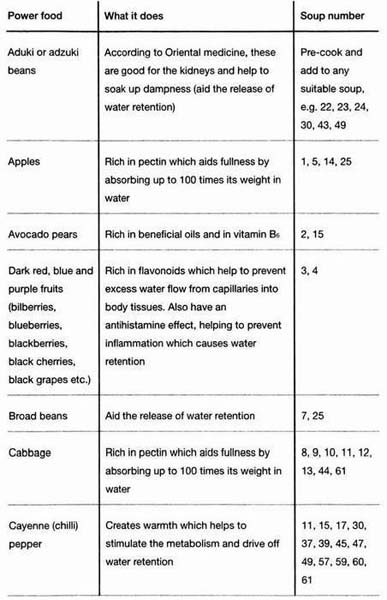
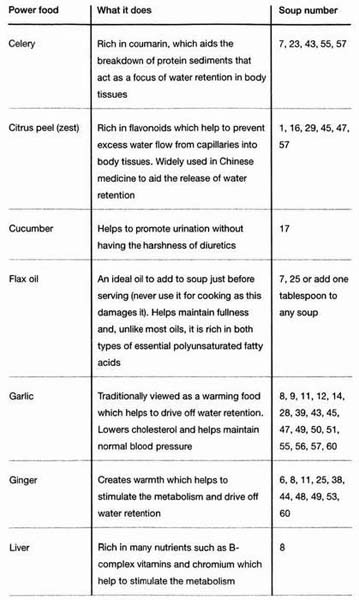
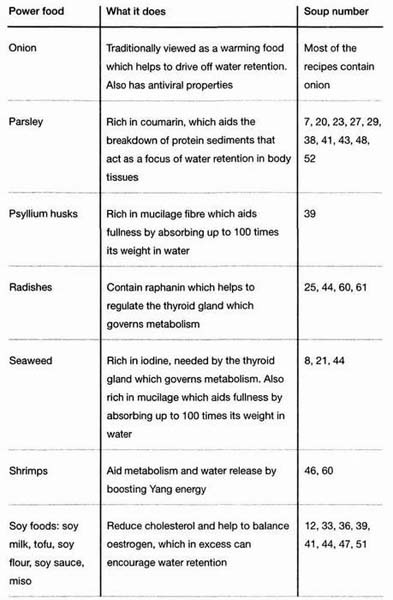
SOUP DIET PROGRAMMES
The two soup diet programmes in this book have been devised for you depending on your needs. If you want to clean out your system, shed some water retention and start getting into a more healthy state, Programme 1: the four-day Mini-detox, is for you.
If, on the other hand, you have some weight to lose, you can go straight to Programme 2: the 10-day Big Healthy Soup Diet. (This starts off with the same four-day Mini-detox.) You can repeat the diet as often as you like until you have reached your target weight. Alternatively, after the 10 days just begin to sample the other delicious soup recipes in this book. They are all designed to help you shed pounds.
Programme 1: Mini-detox
This is designed to
Cleanse and begin to regenerate your digestive system
Balance your blood sugar
Reduce stress on your adrenal glands
Re-hydrate your blood after too much alcohol, tea and coffee—but at the same time release unhealthy water retention from your tissues
Eliminate excess acidity caused by too much meat, fat and sugar
Provide extra antioxidants to combat toxins
Start off the fat-burning process
The most essential part of any detox diet is to consume plenty of liquid. While cold liquids can actually cool and slow down some people’s metabolism, warm liquids and hot soup can energize you and provide all the special ingredients that help to clean out your system. Unlike most detox diets, this one provides protein in the form of nuts, tofu, beans and avocado, so it is also safe to follow for longer periods and can be repeated up to four times (a total of 16 days).
FOUR-DAY MINI-DETOX
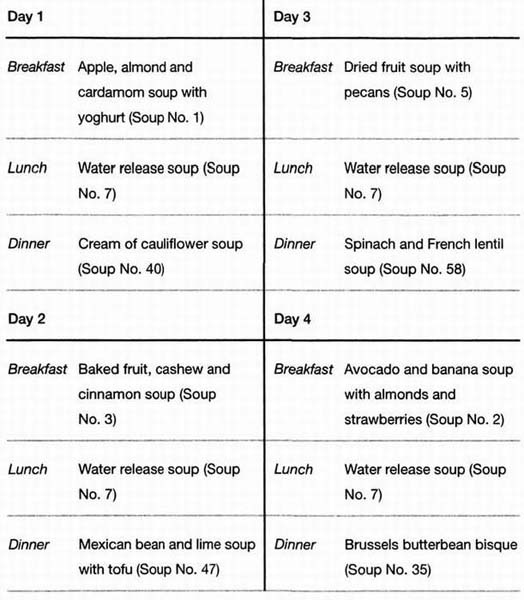
IMPORTANT
Since you should not eat any other foods during these four days, make extra quantities of soup to eat as snacks. But don’t overload your stomach! Part of the detox process involves not giving your stomach so much food that it has difficulty digesting it. Never continue eating beyond the point of feeling satisfied. You should also drink plenty of plain water (2 litres/4 pints a day) to carry away the dissolved wastes in your blood. This water must be plain and unflavoured, otherwise it will have a reduced capacity to absorb wastes and toxins. In addition to plain water, you may also drink fresh fruit juice diluted with water, and the herbal teas listed in the box on page 25.
HERBAL TEAS FOR USE WITH THE MINI-DETOX
Chamomile: Promotes good digestion and helps you sleep
Dandelion root coffee: Helps to drain wastes from the liver
Fennel: Promotes good digestion
Ginger: Aids digestion and warms the circulation
Ginseng: Boosts vitality in older women during and after the menopause
Peppermint: Aids the flow of bile and promotes good digestion
Sage: Helps to relax blood vessels and promote circulation
If you have ajuice extractor, try making juices from a mixture of carrot, radish, broccoli stems and celery. Drinking a wine-glassful of this juice twice a day will help to rejuvenate your liver and aid the release of unhealthy water retention. You can flavour the mixture with lemon juice, which contains ingredients that help to dissolve gallstones. Whizz in some parsley for extra benefits. Better still, dilute the juice with a large glass of water and whisk in a level tablespoon of psyllium husks. Drinks made in this way will help to sweep out your intestines, where toxins can become embedded if you don’t normally have regular bowel motions.
You can stop at the end of the four days if you feel you have achieved the desired results. But if you feel good on this detox it will do you no harm to continue for longer.
Detox effects
All detox diets have side-effects, and this one is no exception. Be especially prepared for a day or two of headaches caused by withdrawal from caffeine. You may also feel a little tired and nauseous. These symptoms should pass as your body adjusts.
THE 10-DAY BIG HEALTHY SOUP DIET
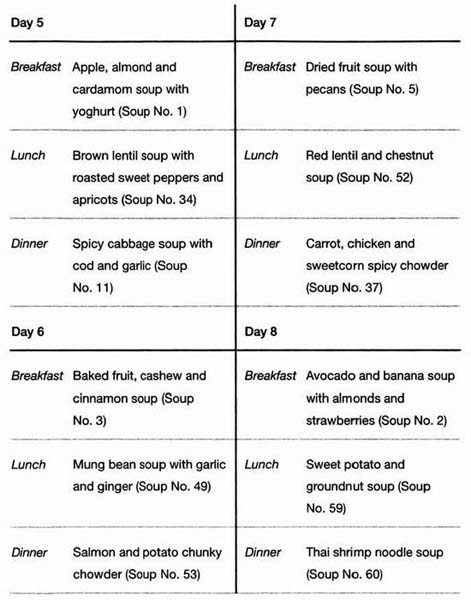
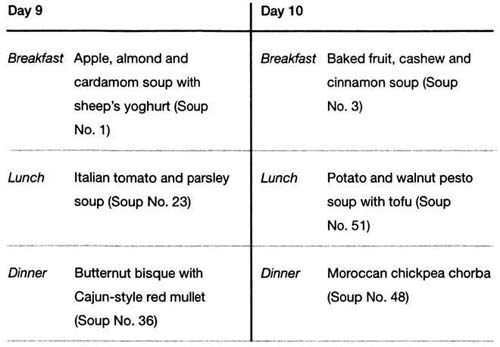
IMPORTANT
During the 10 days, eat only soups as directed. If you feel hungry between meals, snack on soup, if necessary taking one or two vacuum flasks of hot soup to work with you, or a container of ready-made soup which you can heat up at work if you have a kitchen.
If you wish to carry on losing weight after the 10 days, just continue on a soup-only diet, using the recipes in this book. Provided that you eat a soup from either the ‘Cabbage Soups’ or the ‘Substantial Soups’ sections at least once a day, you should not go short of protein. (Alternatively, to protein-enrich any of the soups in the ‘Starters’ section, add a portion of tofu or some poached fish or chicken.)
Since cow’s milk products can cause water retention in some individuals, select the ‘soy milk’ and ‘soy cream’ options where they are offered as an alternative. If you appear to lose a lot of water retention during the 10 days of this programme, you will need to test yourself to find out which foods could be involved. Waterfall Diet publications (see Resources, page 277) are specifically designed to help you do this.
Programme 2: The 10-day Big Healthy Soup Diet
This is designed for longer-term weight loss. It starts with the four-day detox and continues with a further six days of soups to warm your metabolism and help you continue shedding water retention. If you do suffer from water retention, this common problem can easily add 8 lbs to your weight. So you could lose 2 lbs of fat and as much as 8 lbs of retained water by the end of the 10-day programme. That’s a total of 10 lbs!
OTHER WAYS TO DIET WITH SOUP
Research shows that starting a meal with hot soup helps you to reduce the amount of food subsequently eaten. So if you find a soup-only diet a bit too difficult, you can start any meal with a bowl of soup, and you should feel satisfied much more easily. You could also try an occasional ‘soup-only day’.
As you will see from the research at the end of this chapter, you cannot get the ‘soup effect’just by drinking a beverage with solid food. The body seems to be able to tell the difference between liquid that is consumed separately, and liquid which forms part of the food itself.
MAINTAINING YOUR IDEAL WEIGHT
Reaching your target weight is often not the biggest problem with weight control: keeping it is. Yo-yo dieting is common, and is caused by relaxing your eating habits too much for too long once you have got rid of the excess pounds. We are all guilty of throwing caution to the winds after weeks or months of deprivation, and indulging in some ‘well-deserved’ binges. The problem is that we enjoy the binges so much that we can’t stop them, and all our old habits creep back again! After reaching your target weight it really is important to be especially vigilant. If you are longing to binge, then by all means do so, but set yourself a programme and ration your high-calorie binge foods on a weekly basis. Decide in advance how many treats you will buy per week and when you will eat them. Whatever happens, do not keep treats in the home. Even if the treats are for other members of your family, you must make sure that they are not available to you at times when you are not allowed to eat them, as you will be far too tempted to raid the cookie jar when you are a little bit bored, depressed or peckish. The only safe way to ration treats is to buy them as and when you are allowed to eat them, in the exact quantities you are allowed.




